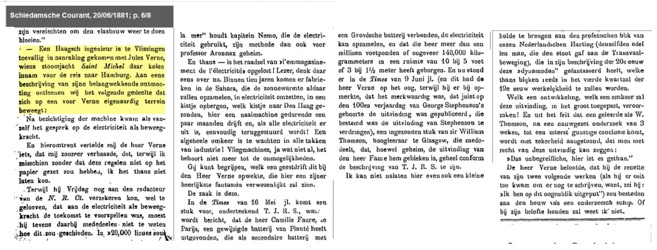From the archive
Click on the images to enlarge them.
An unlikely meeting in 1881
The newspaper Schiedamsche Courant dated June 20th, 1881, carried an article describing an anecdotal meeting with Jules Verne during Verne’s first visit to the Netherlands in that same year. It was published within a week of his departure.

An engineer from The Hague happened to meet Jules Verne in Vlissingen (Flushing), The Netherlands, [in 1881], while his steam yacht Saint-Michel was taking in coal for the voyage to Hamburg. We extract the following from this important meeting, on a for Verne peculiar subject:
After an inspection of the engine, the conversation turned to the role of electricity as an energy source. In this respect, Verne mentioned something which surprised me so much that I felt forced to write it down.
While he could assure the reporter of the N.R.Ct. last Friday that he believed in electricity as the energy source of the future, he had to admit that he did not know how this would work. Therefore, in “20,000 lieues sous la mer” captain Nemo, who is using electricity, keeps the method a secret from Prof. Aronnax.
Now, the enigma of storing electricity has been solved! Reader, consider this. Within ten years, there will be factories in the Sahara to collect solar heat, transform it to electricity, store it in a box, which when sent to The Hague, will power a sewing engine for a couple of months. It can simply be sent back after all energy is consumed. All branches of industry await a general revolution. Aviation, you name it, no longer is impossible.
You will understand Mr. Verne’s enthusiasm, who will thus see one of his most delicious fantasies come true. This is the case:
The Times dated 16th May carries an article signed T.J.R.S., which reports that Mr. Camille Faure of Paris invented a modified Planté battery, which, connected as a secondary battery to a Groves battery, can store electricity. This gentleman was able to store over a million foot pounds or about 140,000 kilogram meters in a space of 10 by 5 foot or 3 by 1.5 meters. In addition, the Times of June 9th (and this is what Mr Verne intended, while mentioning that the publication of this new finding which was destined to replace Stephenson’s, coincided with George Stephenson’s 100th anniversary) contained a letter to the editor by sir William Thompson, professor at Glasgow, who confirmed Faure’s invention, although it was secret, to be in full accordance with the description by T.J.R.S.
I cannot help paying tribute to the prophetic vision of our Dutch Mr. Harting (the same noble character who initiated the Transvaal movement), who in his description of the 20th century fantasized about these “dynamodes”, which will become a reality already in the fourth quarter of the 19th century.
What development, what revolution will this invention bring along when applied on a grand scale! The fact that a scientist like W. Thomson reaches an extremely favourable conclusion demonstrates with certainty that one can say of this invention: “Das unbegreifliche, hier ist es gethan.”
Mr. Verne promised that he would spend the income from his next two books (if ever he manages to write these as he admitted to being exhausted at the moment) on the construction of a submarine. I do not know whether he will live up to his promise.
